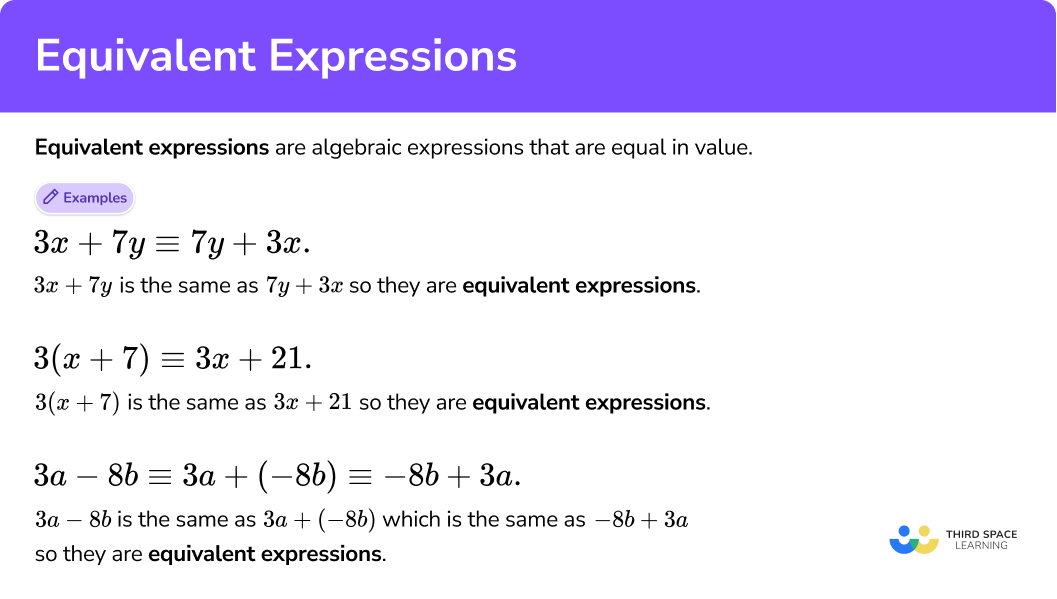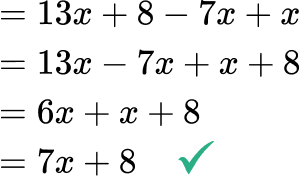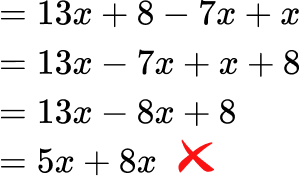High Impact Tutoring Built By Math Experts
Personalized standards-aligned one-on-one math tutoring for schools and districts
In order to access this I need to be confident with:
Add and subtract within 100
Integers Order of operationsEquivalent expressions
Here you will learn about equivalent expressions, including what they are and how to recognize them.
Students will first learn about equivalent expressions as part of expressions and equations in 6th grade.
What are equivalent expressions?
Equivalent expressions are expressions in algebra that are equal in value, even though they look different. Equivalent expressions will have the same value when we use the same value(s) for the variable(s).
An algebraic expression is two or more numbers and letters that are combined with mathematical operations such as +, -, or \div .
To do this, use properties of operations to create and identify equivalent algebraic expressions.
When stating that two expressions are equivalent we use the equivalence symbol \equiv to show that they are identical.
- Addition
Addition is commutative which means changing the order of the terms does not change the sum.
For example, 3x+7y \equiv 7y+3x.
3x+7y is the same as 7y+3x because the coefficients of x are the same, both positive 3x and the coefficients of y are the same, both positive 7x.
This means they are equivalent expressions.
For example, 3a-8b = 3a+(-8b) \equiv -8b+3a.
The negative sign belongs to the term after it. Subtracting a term is the same as adding a negative term.
3a-8b is the same as 3a+(-8b), because subtracting 8b is the same as adding -8b. And by the commutative property, 3a+(-8b) is the same as -8b+3a.
This means they are equivalent expressions.
- Multiplication
Multiplication has a distributive property which allows us to break up a number into simpler parts and multiply each part separately. This can be used with variables as well.
For example, 3(x+7) \equiv 3x+21.
3(x+7) is the same as 3x+21 because 3 \times x=3x , and when you multiply the constants 3 and 7 , you get 21. The right side is the same as the left side.
This means they are equivalent expressions.
What are equivalent expressions?

Common Core State Standards
How does this relate to 6th and 7th grade math?
- Grade 6 – Expressions and Equations (6.EE.A.4)
Identify when two expressions are equivalent (for example, when the two expressions name the same number regardless of which value is substituted into them).
For example, the expressions y + y + y and 3y are equivalent because they name the same number regardless of which number y stands for.
- Grade 7 – Expressions and Equations (7.EE.A.1)
Apply properties of operations as strategies to add, subtract, factor, and expand linear expressions with rational coefficients.
![[FREE] Equivalent Expressions Worksheet (Grade 6)](https://thirdspacelearning.com/wp-content/uploads/2024/02/Equivalent-expressions-worksheet-listing-image.png)
[FREE] Equivalent Expressions Worksheet (Grade 6)
![[FREE] Equivalent Expressions Worksheet (Grade 6)](https://thirdspacelearning.com/wp-content/uploads/2024/02/Equivalent-expressions-worksheet-listing-image.png)
Use this worksheet to check your 6th grade students’ understanding of equivalent expressions. 15 questions with answers to identify areas of strength and support!
DOWNLOAD FREE![[FREE] Equivalent Expressions Worksheet (Grade 6)](https://thirdspacelearning.com/wp-content/uploads/2024/02/Equivalent-expressions-worksheet-listing-image.png)
[FREE] Equivalent Expressions Worksheet (Grade 6)
![[FREE] Equivalent Expressions Worksheet (Grade 6)](https://thirdspacelearning.com/wp-content/uploads/2024/02/Equivalent-expressions-worksheet-listing-image.png)
Use this worksheet to check your 6th grade students’ understanding of equivalent expressions. 15 questions with answers to identify areas of strength and support!
DOWNLOAD FREE
How to identify equivalent expressions
In order to identify equivalent expressions:
- Use the properties of operations to create equivalent expressions.
- Compare the two expressions.
- Make your decision.
Equivalent expressions examples
Example 1: addition and subtraction
Are the expressions 4a+7b and 7b-4a equivalent?
- Use the properties of operations to create equivalent expressions.
Take the first expression and change the order of terms being added: 4a+7b becomes 7b+4a.
Now compare 7b+4a and 7b-4a.
2Compare the two expressions.
The two expressions both have ‘4a’ and ‘7b’, but in the second expression the ‘4a’ is negative. It is ‘-4a’.
3Make your decision.
The two expressions are not the same. They are NOT equivalent expressions.
Example 2: distributive property
Are the expressions 4(x-5) and 4x-20 equivalent?
Use the properties of operations to create equivalent expressions.
Take the first expression and multiply the terms within the parentheses by the term on the outside:
\begin{aligned} & 4(x-5) \\\\ & =4 \times x-4 \times 5 \\\\ & =4 x-20 \end{aligned}
Compare the two expressions.
The two expressions are the same, 4(x-5) \equiv 4x-20.
Make your decision.
The two expressions are the same. They are equivalent expressions.
Example 3: combining like terms
Are the expressions 2g + 3t+8g +6 and 10g + 9t equivalent?
Use the properties of operations to create equivalent expressions.
Take the first expression and combine the like terms:
\begin{aligned} & 2 g+3 t+8 g+6 \\\\ & =2 g+8 g+3 t+6 \\\\ & =10 g+3 t+6 \end{aligned}
The terms ‘10g’ and ‘+3t’ and ‘+6’ are not like terms. This expression cannot be simplified further.
Now compare 10g + 3t + 6 and 10g + 9t.
Compare the two expressions.
The two expressions both have ‘10g’, but ‘3t + 6’ is not the same as 9t.
Make your decision.
The two expressions are not the same. They are NOT equivalent expressions.
Example 4: two step with distributive property
Are the expressions 3(4+s) + 2 and 3s + 14 equivalent?
Use the properties of operations to create equivalent expressions.
Take the first expression and multiply the terms within the parentheses by the term on the outside:
3(4+s)+2=12+3 s+2
Then combine the like terms:
\begin{aligned} & 12+3 s+2 \\\\ & =12+2+3 s \\\\ & =14+3 s \end{aligned}
Compare the two expressions.
Now compare 14 + 3s and 3s + 14. The two expressions have ‘14’ and ‘3s’ and are addition.
Make your decision.
The two expressions are the same. They are equivalent expressions.
Example 5: equivalent expressions with fractions
Are the expressions \frac{1}{2} p+5 p-\frac{3}{4} and 4 \frac{3}{4} p equivalent?
Use the properties of operations to create equivalent expressions.
Take the first expression and combine the like terms:
\begin{aligned} & \frac{1}{2} p+5 p-\frac{3}{4} \\ & =5 \frac{1}{2} p-\frac{3}{4} \end{aligned}The terms '5 \frac{1}{2} p' and '-\frac{3}{4}' are not like terms. This expression cannot be simplified further.
Compare the two expressions.
Now compare 5 \frac{1}{2} p-\frac{3}{4} and 4 \frac{3}{4} p .
Both expressions have the variable p , but not the same amount. The first expression also has -\frac{3}{4} .
Make your decision.
The two expressions are not the same. They are NOT equivalent expressions.
Example 6: equivalent expressions with exponents
Are the expressions y(y-4) and -4 y+y^2 equivalent?
Use the properties of operations to create equivalent expressions.
Take the first expression and multiply the terms within the parentheses by the term on the outside:
\begin{aligned} & y(y-4) \\ & =y \times y-4 \times y \\ & =y^2-4y \end{aligned}Compare the two expressions.
Now compare y^2-4 y and -4 y+y^2 . The two expressions have a positive ‘y^2’ and ‘-4 y’ .
Make your decision.
The two expressions are the same. They are equivalent expressions.
Teaching tips for equivalent expressions
- Introduce equivalent expressions through growing shape patterns. Since a growing shape pattern starts with a shape and changes in a constant way from term to term, algebraic expressions can be used to write the pattern’s general rule. Intentionally choosing a pattern that can be solved in more than one way, allows for students to visually see equality among different expressions.
For example,
Write a rule that will find the total number of squares for any term.
The following rules can be written:
2(n-1) + 5
3 + 2n
1 + 2(n+1)
See also: Shape patterns
- Review the distributive, associative, and commutative properties with whole numbers, before introducing how to use them with algebraic expressions. Students need a clear understanding of these properties and why they work before they can apply them to variables and integers.
- Writing equivalent expressions is a great place to begin with students. Give them an expression and ask them to come up with as many equivalent expressions as possible. Then have them share and justify the equivalence of their expressions with others.
- Encourage students to model expressions that have variables by providing digital resources or physical manipulatives (such as algebra tiles). The amount of time that each student needs to spend with these representations will vary, but it is important that students have a conceptual understanding before they begin to solve by manipulating just the numbers and symbols in an expression.
Easy mistakes to make
- The order of subtraction is important
Remember that the order of a subtraction equation matters because subtraction is not commutative, so changing the order changes the outcome.
For example,
7-4 ≠ 4-7
+3 ≠ -3
- Mixing up the order of operations (pemdas) for simplifying algebraic expressions
The order of operations should always be used to simplify expressions. For any simple given expression, this means using the distributive property to simplify any parentheses and then combining the like terms from left to right. Doing this in a different order will give the incorrect answer.
For example,


- Confusing terms with a coefficient of \bf{1} (or no coefficient)
For terms with a coefficient of 1, you don’t need to write the 1, but remember that it is still there.
For example,
1 y=y \hspace{1cm} 1 c+4 m=c+4 m \hspace{1cm} 6(5+1 e)=6(5+e)
Related algebraic expressions lessons
- Algebraic expressions
- Expanding expressions
- Evaluate the expression
- Combining like terms
- Simplifying expressions
- Polynomial
Practice equivalent expressions questions
1. Which expression is equivalent to 3a-4b?




The commutative property says that the order in which the two terms are added can be reversed and the expressions are still equivalent.
3a-4b=3a+(-4b) \equiv -4b+3a
2. Which expression is equivalent to 3(a+4)?




The commutative property says that the order in which the two terms are added can be reversed and the expressions are still equivalent.
\begin{aligned} & 3(a+4) \\ & =3 \times a+3 \times 4 \\ & =3 a+12 \end{aligned}
3. Which expression is equivalent to 5x+6y?




The commutative property says that the order in which the two terms are added can be reversed and the expressions are still equivalent.
5x+6y \equiv 6y+5x
4. Which expression is equivalent to -4k + 11h+9k +4h?




Combine the like terms:
\begin{aligned} & -4 k+11 h+9 k+4 h \\\\ & =-4 k+9 k+11 h+4 h \\\\ & =5 k+15 h \end{aligned}
5. Which is the equivalent expression to 8(z-4) + 4z?




To create an equivalent expression, multiply the terms within the parentheses by the term on the outside:
\begin{aligned} & 8(z-4)+4 z \\\\ & =8 \times z-8 \times 4+4 z \\\\ & =8 z-32+4 z \end{aligned}
Combine the like terms:
\begin{aligned} & 8 z-32+4 z \\\\ & =8 z+4 z-32 \\\\ & =12 z-32 \end{aligned}
Equivalent expressions FAQs
As students continue to learn about equivalent expressions in middle school, they will be introduced to algebraic expressions that have fractions, decimals, and exponents, including quadratic equations. However, it is important that students do not work on more complicated polynomials until they thoroughly understand how to work with simpler expressions.
Yes, the same strategies for creating equivalent expressions and comparing them can be applied to inequalities.
Both involve two more equivalent entities, but expressions are mathematical statements that do no include the equal sign. An equation on the other hand, includes an equal sign.
An equivalent expression is an expression in algebra that has the same value as another expression but does not look the same. For example, 3x+7y \equiv 7y+3x.
Expressions are equivalent if the same values are substituted in for the variable and both arrive at the same answer.
The next lessons are
Still stuck?
At Third Space Learning, we specialize in helping teachers and school leaders to provide personalized math support for more of their students through high-quality, online one-on-one math tutoring delivered by subject experts.
Each week, our tutors support thousands of students who are at risk of not meeting their grade-level expectations, and help accelerate their progress and boost their confidence.

Find out how we can help your students achieve success with our math tutoring programs.
[FREE] Common Core Practice Tests (3rd to 8th Grade)
Prepare for math tests in your state with these 3rd Grade to 8th Grade practice assessments for Common Core and state equivalents.
Get your 6 multiple choice practice tests with detailed answers to support test prep, created by US math teachers for US math teachers!